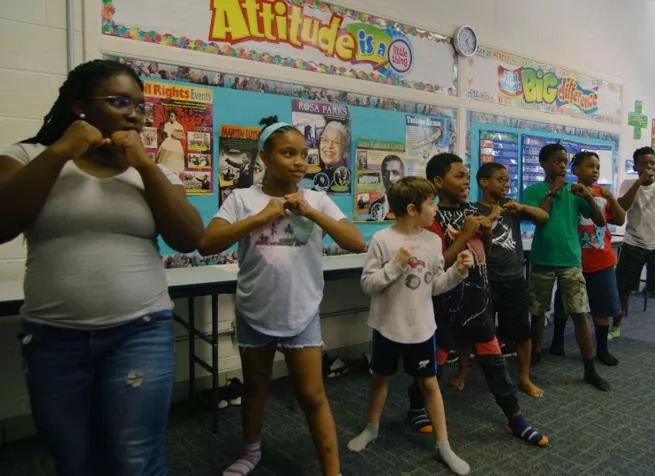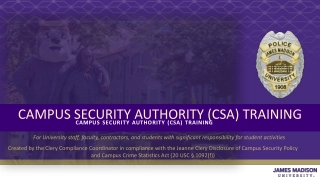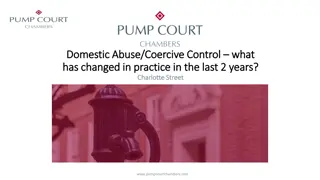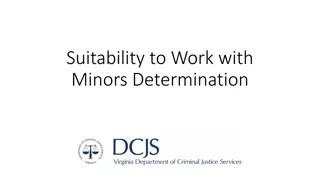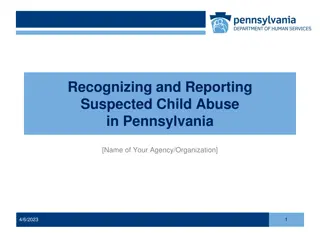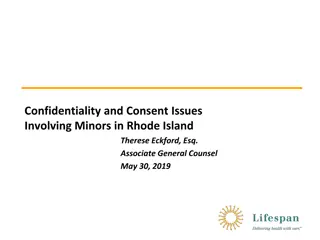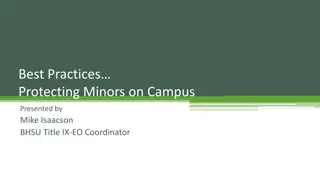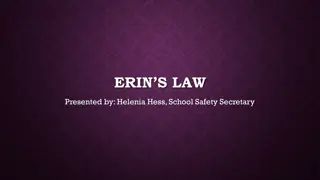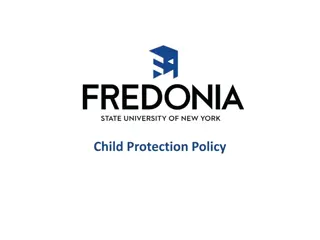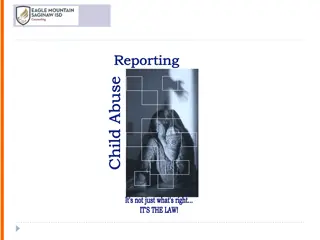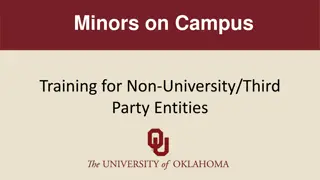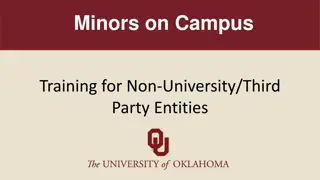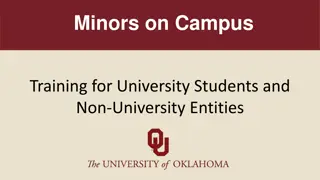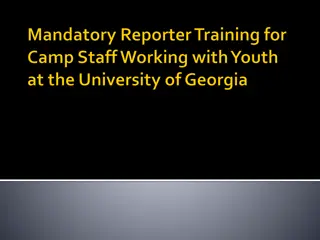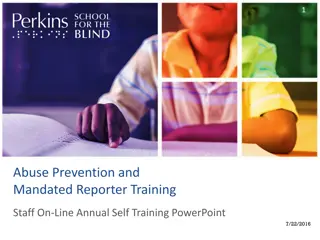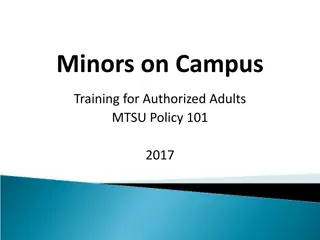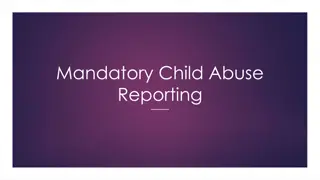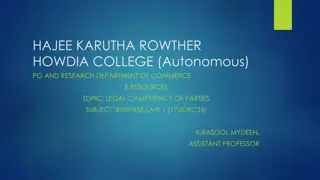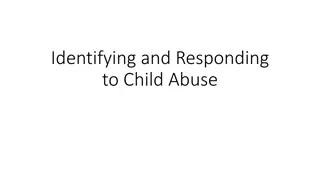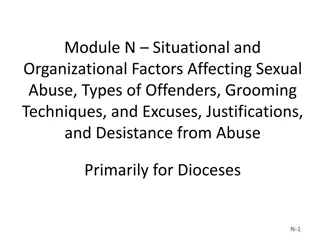Protection of Minors on Campus: Recognizing Abuse & Reporting Training
Addressing the importance of identifying and reporting child abuse and neglect on campus, this training module emphasizes the role of mandated reporters in safeguarding minors. It covers different forms of abuse, peer-to-peer issues, disclosure handling, and available resources, while stressing the legal duty to report suspicions.
Download Presentation

Please find below an Image/Link to download the presentation.
The content on the website is provided AS IS for your information and personal use only. It may not be sold, licensed, or shared on other websites without obtaining consent from the author. Download presentation by click this link. If you encounter any issues during the download, it is possible that the publisher has removed the file from their server.
E N D
Presentation Transcript
The Protection of Minors on Campus: Recognizing Abuse and Mandated Reporter Training Youth Programs and Camps Office East Carolina University
Disclaimer Disclaimer This training contains general information and guidelines. It is not intended to be a comprehensive summary or to address all possible training needs related to reporting. This training module should not be used as a substitute for additional training provided by individual Covered Programs or in place of guidance by administrators of Covered Programs on specific situations.
Disclaimer Continued Disclaimer Continued This training contains sensitive information related to child maltreatment. All content is intended to be educational while aiding program staff in identifying the signs of child maltreatment. This presentation is also meant to highlight staff s duty to report different forms of abuse. This training is self-paced and can be paused at any time. Resources are located at the end of this presentation.
Questions To Be Addressed in Presentation Questions To Be Addressed in Presentation Who are mandated reporters and what protections do they have? What are the different forms of child abuse and neglect, and how are they identified? What is peer to peer abuse and what are the best practices in preventing it? When a child discloses abuse, what should I do with that information? Where can I find resources related to this topic?
Mandated Mandated Reporters Reporters
Mandated Reporter Defined Mandated Reporter Defined In accordance with North Carolina State Law (G.S. 7B In accordance with North Carolina State Law (G.S. 7B- - 301), 301), any person or institution any person or institution who reasonably suspects that a minor has been abused or neglected by a parent, that a minor has been abused or neglected by a parent, guardian, custodian, or caretaker, has an absolute guardian, custodian, or caretaker, has an absolute obligation to report that suspicion to the appropriate obligation to report that suspicion to the appropriate County Department of Social Services (County DSS) and County Department of Social Services (County DSS) and Law Enforcement (LE), regardless of where the offense Law Enforcement (LE), regardless of where the offense occurred. occurred. ECU extends this guidance to encompass reporting all ECU extends this guidance to encompass reporting all forms of child maltreatment, including peer forms of child maltreatment, including peer- -related abuse or inappropriate conduct involving a minor. abuse or inappropriate conduct involving a minor. who reasonably suspects related
Examples of Mandated Reporters at the University Examples of Mandated Reporters at the University Faculty Staff Interns Students Temporary Employees Junior Staff Visiting Scholars/ Practitioners Volunteers University Affiliates (including employees/ volunteers working with a Third Party Program) ***Note: ECU employees should contact Bret Wilson, ECU Clery Coordinator, to schedule Clery Training as needed.
Protections for Mandated Reporters In accordance with state law, if you make a report about suspected child In accordance with state law, if you make a report about suspected child maltreatment in good faith, you will receive immunity from possible civil or maltreatment in good faith, you will receive immunity from possible civil or criminal liability that may result from your report. criminal liability that may result from your report. In addition, no member of the University Community, including Covered In addition, no member of the University Community, including Covered Individuals, making a good faith report of suspected abuse or neglect will be Individuals, making a good faith report of suspected abuse or neglect will be retaliated against in the terms and conditions of employment, or within retaliated against in the terms and conditions of employment, or within participation of educational programs or activities, as applicable, for adhering participation of educational programs or activities, as applicable, for adhering to the Protection of Minors Regulation and North Carolina law. to the Protection of Minors Regulation and North Carolina law.
Abuse and Neglect Abuse and Neglect Defined Defined
Defining Abuse Defining Abuse Abuse According to the Department of Social Services, abuse is, Any act or series of acts of commission or omission by a parent, guardian, or other caregiver that results in harm, potential for harm, or threat of harm to a child. Sexual Peer to Peer Emotional Abuse Physical Neglect
Physical Abuse Any nonaccidental serious injuries, pattern of injuries, or risk of serious injury to a child. Serious is intentionally not defined, but may include: Beating Use of a weapon Use of harmful restraints Burning Biting Hitting Shaking Kicking Physical Indicators Bruises at different stages of healing and in different shapes Marks inconsistent with single-side fall or explanation for injury Behavioral and Emotional Indicators Excessive absences Fear of parents or adults Extreme aggression Cognitive or intellectual impairments Deficits in speech and language Hyperactivity, impulsivity, and low frustration tolerance Depression, low self-esteem, and suicidal thoughts or tendencies Constant fatigue or inability to stay awake Is easily agitated or defensive
Emotional Abuse A pattern of verbal assaults or coercive measures against the child, which is destructive to the child s sense of self-worth, including: Sustained and repetitive criticism, shaming, or belittling Setting unrealistic expectations Blaming a child for things they have no control over Terrorizing a child by destroying treasured belongings, relationships, or supports Intentionally isolating a child Rejecting or consistently favoring another child or sibling Withholding love or affection Behavioral or Emotional Indicators Low self-esteem or self-worth Suicidal thoughts or ideations Self-critical or overly anxious Bullying or criticizing others Guardian severely criticizes child in front of others, including: Leaving a competition because of a child s failure to perform Depicting normal developmental activities harshly, including shameful name-calling
Sexual Abuse Prevention Trainings in NC Stewards of Children: Darkness to Light Stop It Now Physical acts perpetrated upon a child Examples include: Sexual intercourse, fondling, oral- genital contact Signs Physical signs are not common, but the following may be presented: Bruising, bleeding, redness, etc. around the genitals Sexually transmitted diseases Chronic stomach pain, headaches or other ailments that can t be explained medically Grooming Signals Grooming is the process of gaining the trust of a child or their family so that the perpetrator can gain access to a minor Signs: gift-giving, doting, seeking one-on-one interactions, encouraging secrets, giving minors access to restricted things, testing physical boundaries Non-touching acts perpetrated upon a child Examples include: taking obscene pictures or videos of minors, exhibitionism, holding sexually explicit conversations with or around minors Notes: In North Carolina, no minor under the age of 16 can legally consent to a sex act. Depending on the circumstances, acts between minors may need to be reported and investigated.
Peer to Peer Abuse Physical acts perpetrated upon a child by older, or more powerful children of the same age Examples include- Sexual intercourse, fondling, oral-genital contact Non-touching acts perpetrated upon a child by older, or more powerful children of the same age Examples include- taking obscene pictures or videos of minors, exhibitionism, holding sexually explicit conversations with or around minors, sexting, experimentation Notes: In North Carolina, no minor under the age of 16 can legally consent to a sex act. Depending on the circumstances, acts between minors may need to be reported and investigated.
Video on Preventing Peer to Peer Abuse
Assumption VS Reality The Assumptions The Realities Abusers are adults Abusers are seasoned predators We can KEEP them OUT It isn t happening here or It can t happen here Child on Child abuse is just as common Often starts with bullying Doesn t have to involve touch Assume it is happening now
What are the characteristics? Same or different ages Same or different sexes Bullying Coercive Behavior Power imbalances
Strength /Size 3 Types of Power Social Intellectual
Assumption Reality Only problem youth abuse According to Redwoods Insurance 60% incidents are child on child. Darkness2Light Foundation identifies 70% child on child. We should only worry about severe cases Cases of bullying grow and often lead to child-on-child abuse 74% involve similar ages (+/-1) It s rare and unlikely Incidents are under-reported
How can it happen? 1. Isolated 1-to-1 2. Physically isolated areas 3. In the presence of distracted adults/out of line of vision
Assumption Reality Requires complete privacy Even small lapses in supervision are dangerous If staff or cameras, are present we are safe Those that abuse are good at not being detected I would see it and stop it It can even happen in full view You don t catch people abusing children, you catch them breaking the rules and pushing boundaries.
Where and when does it happen? Private Locations: Bathrooms, locker rooms, cabins Obstructions: Playground Structures, closets, bus seats, underwater Transition times: Transportation, sign- in/sign-out, beginning/end of day
Open mind and open eyes Any obstruction creates privacy and potential Towels, bus seats, furniture all create risk Abuse happens on camera Abuse happens with adults present
The good news is, we can create safe environments
Tips for Youth Program Planning Staff programs/camps with proper ratios Program in appropriate age groups Rule of Three Keep your program goers active Pay attention to changes in behavior
Preventing Risky Situations Be aware of personality types and conflicts Plan groups to avoid power imbalance Follow supervision protocol Do not allow alone time Model healthy behaviors- no teasing, favoritism, or bad language *You don t catch people abusing, you catch them breaking the rules and pushing boundaries
Identify Red Flag Behaviors Physical aggression or bullying Sexualized language or behavior Inappropriate touch Youth sneaking off/seeking privacy
Code of Conduct Review behavior policies with program goers Training staff on proper boundaries Document all incidents Know when to report and who to report to
Respond to Red Flag Behaviors 01 02 03 04 Separate youth in conflict Address teasing before it becomes bullying Actively follow- up with victims Report concerns to supervisor
1 out of 10 children are sexually abused before their 18th birthday 90% of children who are sexually abused are abused by a family member or someone they know Additional Additional Research Research 35% of child victims are 11 years old or younger. Youth are the victims of 66% of all sexual offenses reported to law enforcement. Less than 2% of sexual abuse allegations are false
Defining Neglect Defining Neglect Neglect Failing to provide for a child s basic needs, including: Physical Ex: Improper clothing for weather conditions; lacking in food or other resources; abandonment Ex: Lacking in adequate supervision (NC law does not define a minimum age in which children can be left alone, but fire code denotes age 8 as a minimum age) Medical Ex: Failure to provide adequate treatment Educational Emotional needs Inappropriate discipline Physical Neglect Medical Emotional Educational
Disclosures Disclosures
Listen calmly and openly Don t fill in the gaps or rush to get to the bottom of it Do not plant ideas, but rather note exact language used by the child Ask open-ended questions and be affirming by saying things like, It s okay to tell me more Believe the child Let them know it is not their fault Do not make promises you can t keep (like this will never happen again) Observe personal boundaries (especially hugs) React React Responsibly Responsibly
Understand How Understand How Disclosures By Children Disclosures By Children May Differ May Differ Children may ask hypothetical questions or pretend the abuse has happened to someone else to gage your reaction The minor may shut down or take back what they said because of fear or shame Children may disclose parts of what has happened rather than all Communication may be masked or nonspecific, for example, Somebody keeps bothering me
Written Disclosures Written Disclosures Disclosures may come in any form, including written, oral, and observed. Often, this occurs in application essays. The same criteria applies for reporting: if there is reasonable suspicion leading you to believe that abuse occurred, you must report. If a person over the age of 18 discloses historic abuse, staff are not required to report unless there is reason to believe that a minor may be at risk of abuse.
Reporting Reporting
Make a Make a Report Report IF YOU SUSPECT THAT A MINOR IS SUFFERING ABUSE OR NEGLECT. REGARDLESS OF WHERE THE ALLEGED ABUSE IS OCCURRING. IF YOU KNOW THAT A MINOR IS SUFFERING ABUSE OR NEGLECT.
Emergency Situations In the event of an emergency or imminent danger, call 911 or the local law enforcement agency with jurisdiction. ECU Police can assist with on-campus crimes or referrals. The ECU Police non-emergency number is 252-328-6787.
Calling Department of Social Services Reports or referrals must be made to the Department of Social Services in cases involving child maltreatment A directory of all 100 county Department of Social Services can be found at Local DSS Directory The reporting county for all reports involving minors in Greenville is Pitt County Report to Pitt County DSS by calling 252-902- 1110. For after-hours incidents, call the Pitt County Sheriff s Department at 252-830- 4141 and ask for the social worker on call.
Helpful Information to Include Helpful Information to Include in a Report in a Report Name, age, address of victim Ensure your registration requires a physical location address rather than a PO address Name and address of parent/ guardian/ caretake Information on other children in the home Details about the abuse allegation
Internal Reporting Programs can neither delay nor prohibit staff from reporting suspected child abuse or child neglect. Supervisors can request that employees or volunteers notify leadership if that request will not cause interference with an investigation. After reporting to external agencies, Covered Programs must submit a detailed report to the Coordinator of Youth Programs and Camps. Internal reports do not relieve staff of their duty to report to DSS or law enforcement.
Additional Resources Additional Resources
Resources Resources Child Welfare Information Gateway North Carolina Department of Social Services Prevent Child Abuse North Carolina US Center for Safe Sport
Questions? For more information or questions, contact Omari Tait, Asst Director Youth Programs/Special Populations at taito21@ecu.edu or 252-328-4759
Sources Cited The 5 Steps to Protecting Our Children - An Introductory Guide to Help Adults Protect Children From Sexual Abuse. (n.d.). Retrieved December 1, 2020, from https://www.d2l.org/education/5-steps/. About DSS. (n.d.). Retrieved from https://www.ncdhhs.gov/divisions/dss. Child Maltreatment Training: FREE Online: Prevent Child Abuse NC. (n.d.). Retrieved December 1, 2019, from https://www.preventchildabusenc.org/recognizing-responding- online-course/. Redwoods Mandated Reporter Training- Retrieved April 2, 2022
Record of Completion To record completion of this training, follow this link: https://ecu.az1.qualtrics.com/jfe/for m/SV_4PalZoXs7NEYTA1








